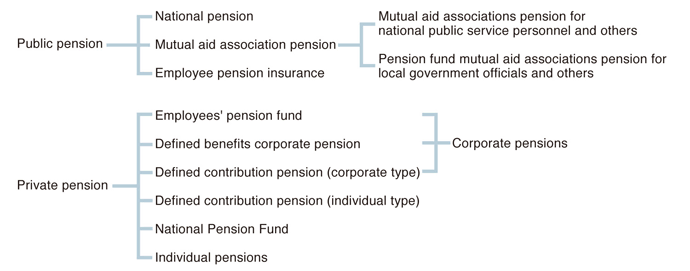Pension trusts
Japan's pension system
Japan's pension system is broadly categorized into public pensions and private pensions, according to the managing entity.
Public pensions are managed by the government or relevant public entity and provide additional benefits to the basic pension plan for income as a form of social security.
In contrast, private pensions refer to individual pensions that are managed by companies (business owners) and business associations, as well as individuals preparing for old age. Pensions managed by companies (business owners) for their employees are called corporate pensions.
Corporate pensions comprise the employees' pension fund system, the defined benefits type corporate pension system, and the defined contribution pension (corporate type) system.
List of public pensions and private pensions

Categories of pension trusts
Corporate pension trusts refer to trusts wherein companies (business owners) entrust funds to trust banks to provide for benefit payments in accordance with the employees' pension fund system and the defined benefits type corporate pension system. Trust banks also provide administrative services for the management and operation of the system.
In addition, the funds to provide pension benefits entrusted to trusts banks by the National Pension Fund in accordance with the National Pension Fund system are called the National Pension Fund Trust.
Defined contribution pension
The defined contribution pension was introduced with the enactment of the Defined Contribution Pension Act in October 2001.
Defined contribution pensions clearly separate payments by each individual, with the determination of the pension benefit based on the aggregate of such payments and investment returns. The amount of future benefits varies with the performance of the investment during the period of contribution. In addition, the funds managed for each individual can be transferred if the member leaves or changes employment. The investment instructions provided by each individual and this portability are major features of defined contribution pensions.
There are two types of defined contribution pensions: (1) a corporate-type pension established by business owners based on agreements between the owners and their workers, wherein members are employees under 60 years of age and (2) an individual-type pension provided by the National Pension Fund Association to applicants who are self-employed or employees under 60 years of age but not eligible for a corporate-type pension. Both are private pensions, but the corporate-type pension is categorized as a corporate pension. Premium payments by business owners can be treated as a loss, while payments by employees can be treated as tax exempt in total income. Both legally fall within the defined contribution system.
Employee retirement benefit trust
The accounting for the employee retirement benefits system was applicable from the fiscal year beginning on April 1, 2000, and companies have subsequently been required to disclose their liabilities pertaining to the employee retirement benefit system that includes corporate pensions and lump sum retirement benefits (retirement benefit liabilities). Trust banks have handled employee retirement benefit trusts as a trust product to reduce shortfalls in pension asset reserves.
An employee retirement benefit trust comprises securities and other assets of a company corresponding to the employee retirement benefits to be paid by the company entrusted to a trust bank that manages such a trust on behalf of the company's employees and retirees.
When a company establishes an employee retirement benefit trust, the retirement benefit liabilities can be reduced by the mark-to-market valuation of the securities and other assets contributed as trust property.
Types of trusts | Money trusts & Loan trusts | Investment trusts | Family trusts·Inheritance - related operations | Real estate trusts·Real estate business | Pension trusts | Asset formation trusts | Asset securitization type trust(monetary claims trusts, real estate trusts) | Securities trusts | Securities trusts (specified money trusts, fund trusts) | Stock Transfer Agencies | Charitable trusts | Specified donor trusts | Product expectations







